Last Updated on March 14, 2024 by Aftab Tariq
Bristlenose Pleco has gained popularity due to its smaller size than other catfish, such as the common pleco, which can reach 18-20 inches long. David Brown says,
“Bristlenose Plecos: tiny algae-eating heroes with big personalities.” –
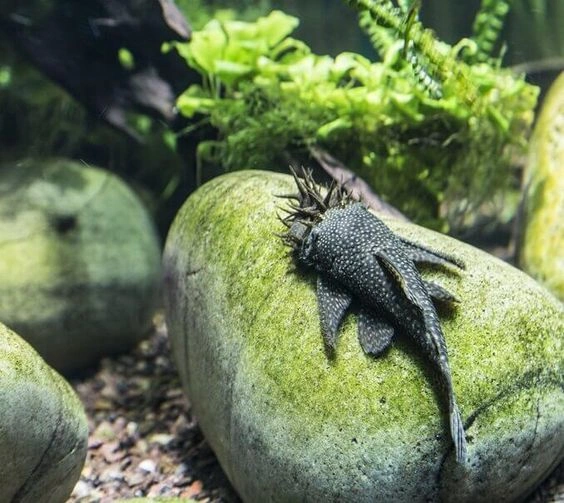
Like other algae-eaters, the bristlenose pleco is a diminutive catfish with a mouth adept at suctioning algae from your aquarium. Bristlenose pleco is a special and interesting fish that many like keeping in freshwater tanks.
Some folks find them fascinating and cool, while others might think they’re strange or spooky. If you’re someone who finds them cool, then this guide is just for you. You’ll discover all the important things about taking care of Bristlenose Pleco and some other cool facts that you might find useful.
What is Bristlenose Pleco?
Bristlenose Pleco are cool-looking fish that love eating algae, making them awesome for aquariums. They’re super popular with new fish owners because they’re easy to take care of, and they keep the tank clean.
Originally, these fish come from rivers and streams in the Amazon Basin, but you can also find them in other parts of Central and South America. Scientists first studied them in the 1800s, and people worldwide love having them in their fish tanks.
Even though they’re similar to other types of catfish and Plecos, Bristlenose Plecos have their own special needs.
Bristlenose Pleco Appearance
The Bristlenose Pleco has a distinctive feature: bushy nose appendages that grow from their snouts. These tentacles give the fish its name and usually appear once the fish is about 6 months old.
These “bristles” are more noticeable in males, longer, and higher on their heads. Females have less prominent bristles around their mouths.
Their mouths are on the bottom of their bodies, which helps them feed on algae on the tank floor and cling to vertical surfaces. Compared to other Plecos, they have elongated lips. Their heads are wider and shorter, making them look a bit plumper.
Bristlenose Pleco has bodies covered in bony plates, protecting them from predators in the wild. They have a base color with lighter dots scattered all over, usually white or yellow. Their bellies are slightly lighter in color.
Albino Bristlenose Pleco
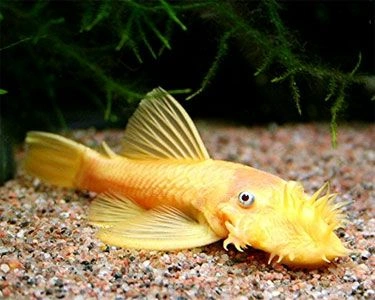
The Albino Bristlenose Pleco is a very popular type of fish. Many people like it because it looks different from other kinds of fish. You can tell it apart because it has a light yellow and pink body color. Also, it has a faint pattern of light spots.
Calico Bristlenose Pleco
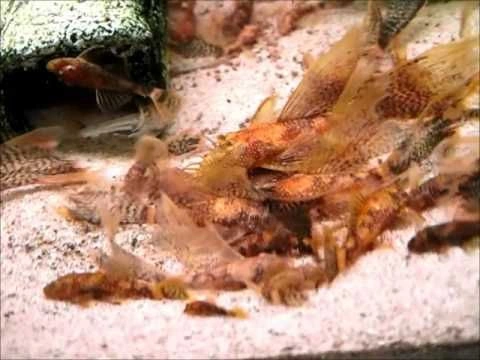
The Calico Bristlenose Pleco is a cool type of fish that looks interesting when you see it. Its body is mainly orange, with some dark patches scattered around, giving it a textured appearance. Lots of people who have freshwater aquariums really like this fish.
Longfin Bristlenose Pleco
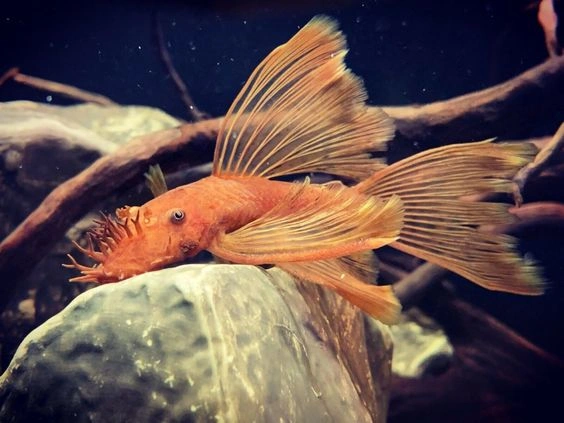
The Longfin Bristlenose Pleco is a cool fish because of its long fins, as its name suggests. Unlike other types of Bristlenose Pleco, its fins are long and flowy, which makes it look like it’s swaying hypnotically as it swims. Watching this type of Pleco swim around is fun, so many people like to get one.
Starlight Bristlenose Pleco

The Starlight Bristlenose Pleco is our top choice among this fish’s variations due to its mesmerizing pattern and colouration. With a predominantly black body adorned with evenly distributed white dots, it presents a striking appearance.
Also, delicate white stripes adorn the dorsal and caudal fins, contributing to its captivating display.
Super Red Bristlenose Pleco

Thefalbino bristlenose pleco Super Red Bristlenose Pleco is special because of its bright colors, as the name suggests. Its body is mostly orange and light red, making it stand out in your fish tank, even if you have other fish.
Bristlenose Pleco Lifespan
The Bristlenose Pleco can live up to five years in captivity if it is well cared for and in the appropriate tank conditions. The record for the oldest living Bristlenose that has been kept in captivity is twelve years old.
Bristlenose Pleco Size
Bristlenose Pleco is usually a small fish. Bristlenose pleco max size is between 18-20 inche. Some types, like the Longfin, might be even smaller, but how you care for them and their genes mostly decides their size.
Bristlenose Pleco Care
Taking care of Bristlenose Pleco is pretty simple once you know what to do. Unlike some other fish, they don’t usually get sick easily. But sometimes they might have common issues like Ich or bacterial infections.
Still, they’re pretty tough little guys and can handle different tank conditions as long as the tank is well looked after.
These Plecos originally come from the Amazon, so making their tank feel like home is important. They like warm water, not too strong currents, and lots of oxygen.
Size of Tank and Contents of Their Habitat
It would help if you had a 25-gallon tank to keep a bristlenose pleco. If you wish to keep them with other fish, expand the tank.
These Plecos like to hang out at the bottom of the tank, so setting up their home with lots of hiding spots is important. Things like plants, wood, and caves are perfect for them to feel safe during the day and for later breeding.
Bristlenose pleco is great at eating algae, which helps keep the tank clean. But they still make waste, so you’ll need a good filter to keep the water healthy. Experienced fish keepers often use canister filters, like the Fluval FX4 or FX6, because they’re good at cleaning up waste.
They also work well with an under-gravel system, which helps keep the tank bottom clean and the water full of oxygen.
Essential Water Conditions
Once your tank is all set up, it’s important to ensure the water conditions are just right for your Bristlenose Pleco! These fish can live in different conditions, but here’s what you should aim for to keep them healthy:
- Water Temperature: Keep it between 60 and 80 degrees Fahrenheit.
- PH Level: Aim for somewhere between 6.5 and 7.5.
- Water Hardness: Aim for 6 to 10 KH.
Adult Bristlenose Pleco can handle changes in water quality well. If you’re new to fishkeeping, starting with adult Plecos is better. Younger ones might have trouble if the pH levels change too much.
Bristlenose Pleco Food
Bristlenose Pleco eats various things when they’re swimming in rivers and streams. Mostly, they munch on plants they find at the bottom. They also eat algae and tiny bugs stuck on plants. In fish tanks, you can give them sinking pellets or wafers made for bottom feeders.
They should eat once or twice a day. Sometimes, they enjoy protein foods like bloodworms, even though they mostly eat plants. Some people give them veggies like peas and cucumbers, which they eat slowly.
Remove them after a few hours to keep the tank clean. If your fish start looking dull, they might need more food variety.
The Significance of Plants and Driftwood
Adding driftwood to your fish tank is a smart move. Driftwood is like a magnet for algae, which is great because Bristlenose Pleco loves munching on algae. They’ll happily clean the green stuff off the driftwood, which is good for their health as it provides them with fibrous material.
If you’ve got live plants like hornwort or Java moss in the tank, your Plecos might even snack on algae growing on their leaves. Usually, Plecos won’t nibble on the plants themselves. However, if they do, it’s a sign they might need more food. Try giving them meals more often if this happens.
Bristlenose Pleco Temperature
Bristlenose Pleco is a calm and friendly fish. They get along well with other peaceful fish in the tank. Since they hang out at the bottom, they don’t usually bother fish swimming higher up. During the day, they’re chill and blend in with their surroundings.
You might need help to spot them because of their camouflage colors. They like to hang out in caves and dark spots. At night, they become more active. They swim around, searching for food in the gravel. Once they find a good spot with lots of algae, they munch away until morning.
Potential Tank Partners
Bristlenose Pleco are friendly fish and get along well with other calm species in the tank. Good tank mates include Neon Tetras, Platy fish, and Guppies. Some people even mix them with aggressive fish like bettas or African cichlids, but we strongly advise against it.
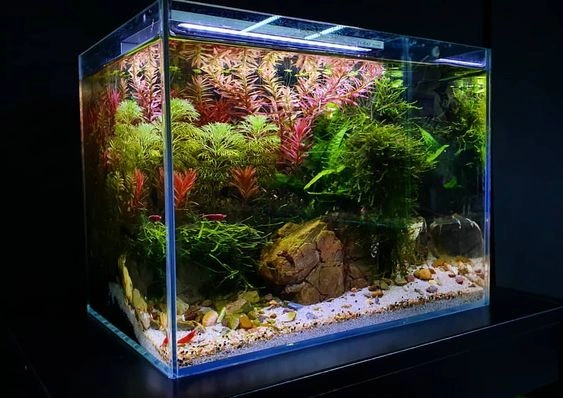
While Bristlenose Pleco has armour-like protection against small aggressive fish, keeping the tank peaceful is best. Pairing them with aggressive fish can stress them out and cause health problems. Be careful if you want more than one Bristlenose Pleco in your tank.
Having more than one male in the same tank is not recommended. Male Plecos can be territorial, especially during breeding time. They like to claim caves or hiding spots, which can lead to fights in smaller tanks.
Bristlenose Pleco Breeding
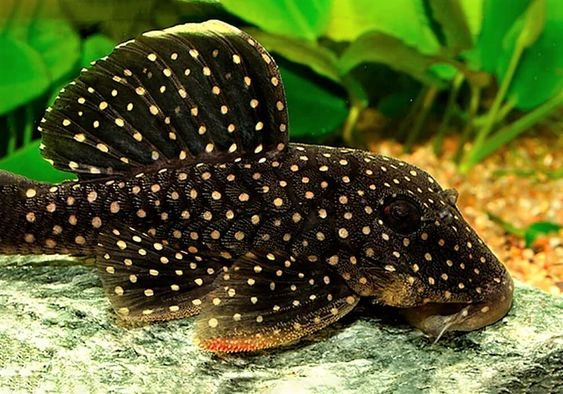
Breeding Bristlenose Pleco is quite manageable if you set up the right conditions. Having a separate breeding tank is a good idea because other fish might try to eat the babies once they’re born.
In their natural habitat in South America, Bristlenose Pleco breeds during the rainy season when the water is cooler. You can mimic this by doing a 75 per cent water change with slightly cooler water in your tank to improve breeding success.
What is the Breeding Process?
Breeding Bristlenose Pleco is straightforward. Just make sure you have more female Plecos than males in your tank. Males can be a bit bossy when it’s breeding time. If you have more than one male, give them plenty of space and hiding spots to avoid arguments.
When it’s time to breed, the male looks for a good spot for the female to lay her eggs, like a cozy cave. Once they find a spot, the female lays her sticky, orange eggs all over the cave.
Both parents monitor the eggs until they hatch, which takes 4–10 days after the male fertilises them. During this time, the male keeps the eggs clean and helps them grow with his tail.
Unlike some fish, Bristlenose Pleco are good parents and protect their babies. After hatching, the little Plecos stick to the cave walls for a few days, feeding on their egg sacs before swimming freely in the tank.
You can give them mashed veggies along with algae to eat. They grow fast and become adults in about 6 months. When they’re young, they don’t have the cool bristles like their parents, but they’ll grow them later.
Frequently Asked Questions
What Bristlenose Plecos Eat?
Provide algae or spirulina wafers once or twice a day; bristlenose Plecos are herbivores and eat mostly algae.
What is the Average Lifespan of a Bristlenose Pleco?
When given the right care, bristle nose plecos are resilient fish with a long lifespan. They can survive up to 12 years or longer in captivity; however, they normally only live 5 to 7 years in the wild.
What is Bristlenose Pleco Tank Size?
Bristlenose Plecos require a minimum tank size of 25 gallons.
Sources
Bristlenose pleco fish species profile
Things to know about Bristlenose Pleco
I am a dedicated content writer with more than five years of experience, particularly skilled in the art of storytelling. My writing journey commenced during my college years, where I pursued journalism and unearthed my talent for creating captivating narratives.


